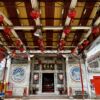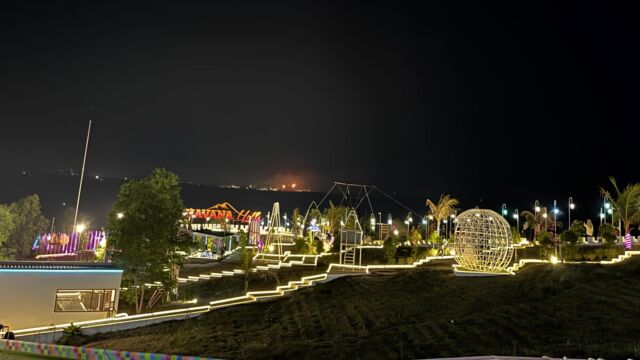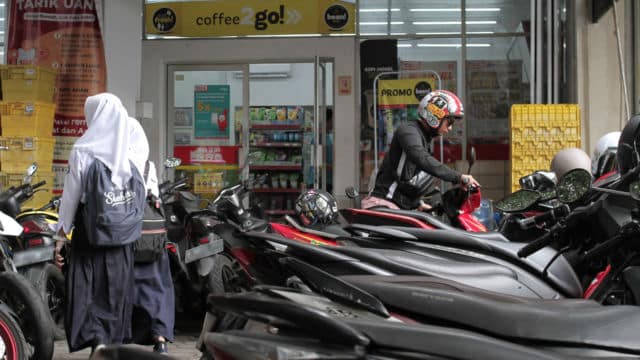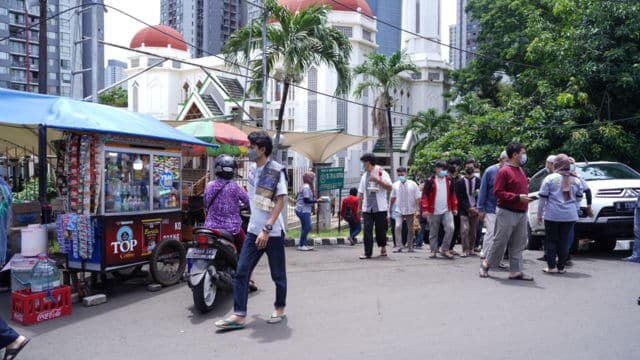In Bandung, a Place of Diversity, and a Place to Sleep Soundly
Photo: One of the main thoroughfares in a private housing complex in Kopo, Bandung. Photo: Joan Oktavianie
A housing complex in Kopo | 2,000 words | Translated from Bahasa Indonesia by Lise Isles
Traffic jams are part and parcel of Kopo, a district in the south of Bandung, West Java. So much so that ‘traffic jam’ and ‘Kopo’ could be synonyms. Kopo equals traffic: almost every denizen of Bandung knows it. One day, when I was going home on an app-ordered scooter taxi, the driver, matter-of-factly, said, ‘The traffic here is like getting tortured. How can you put up with living here, sister?’
I laughed. The traffic, indeed, tests one’s patience. But for we who live here, it’s just one small challenge to be faced down to reach this place we are able to call home.
Kopo has several private housing complexes. They have names like Kopo Permai, Kopo Elok, Taman Kopo Indah, Bumi Kopo Kencana, and so on. My family has lived in one of them since 2002. It has a lot of Chinese-Indonesian residents.
Long ago, my mother told me her story. When she was small, her family were poor, and lived in an area stereotyped as full of pickpockets and thieves. Outsiders belittled whoever lived there, considered them to be undesirable. Additionally, my mother and her family often felt unsafe because they were of Chinese-Indonesian descent, and at that time, racist acts were rampant. The place could not be said to be conducive to happiness.
Later, when my mother met my father and they started a family, she didn’t want her children to experience the same things as her, and my father agreed. Even though my father is Javanese and we’re an assimilated family, my father could understand my mother’s anxiety, and likewise wished to guard his children from the invective of ignorant people. So we came to choose a housing complex in Kopo as a place of safety and a place of comfort for us as a family.
Though the various housing complexes of Kopo have different names, they have similar characteristics. Wide streets – wide enough to easily accommodate cars and even trucks. Houses with neat tiled floors, and walls and fences. The interiors of houses designed with highly-similar spatial plans. The outside areas of houses made uniform. And all houses lined up and pressed-together to form blocks, the walls touching each other.
It’s true that sometimes I can hear a neighbour speaking loudly, or some object falling in a neighbour’s house. But not often. Aside from things like that, the housing complex is almost always quiet. Especially at night. Which is good for me, who can only be productive, and sleep soundly, when things are quiet.
While Kopo’s residents are disproportionately Chinese-Indonesian, that doesn’t mean it’s an exclusive place. Other ethnicities and religions have also come here to live. Apart from churches, mosques have also been built, with the arrival of greater numbers of Muslim residents.
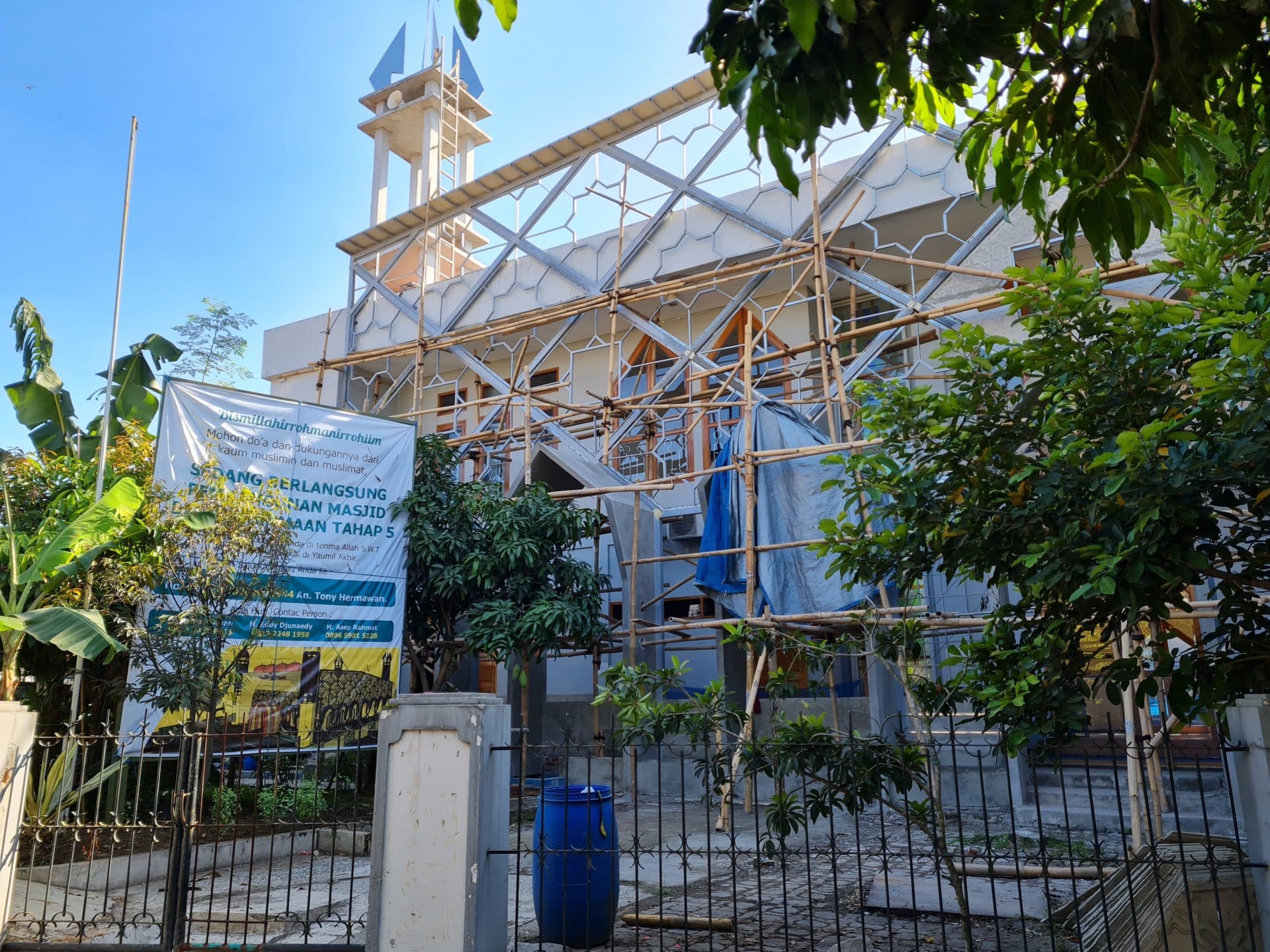
Close to our house there’s a mosque, fairly large. When the adhan echoes out, we can see our neighbours who are Muslim walking over there to pray. Not uncommonly I’ll see people who live further away, too, coming in vehicles to gather at that mosque. In the past I was a little more ambivalent, even felt rather disturbed to hear the adhan. Strangely, the adhan of early morning didn’t bother me, never actually made me wake up. It was the adhans of the afternoons and evenings that often disturbed me at that time. But when I hear the adhan now, I’m as if reminded to rest a little, and I halt whatever I’m working on for a moment. Slowly, I’ve started to be able to enjoy the adhan.
This place is well-suited for people who like to exercise, as they can walk around the complex grounds. The vehicles in the streets move slowly, and the environment can be categorised as safe, as there’s lots of CCTV spread throughout the grounds. Though unfortunately, not every road has CCTV.
If I think about it, the CCTV is usually installed in places that are typically busy, around a park or oval or church or mosque. In areas that are quieter, there are guardposts. These are generally structures of around three by three by two metres, with a single door and a long glass window. The windows are large so that people can easily see inside them.
Kopo has opened a path for me to study diversity deeply. Living here, I’ve tried to study why people will do or believe something that’s different from me.
When I pass such posts, I look in at the table, chairs, TV, water dispenser and fan, and the one or two people currently on shift. Sometimes they’ll be discussing celebrities, sometimes the road repairs currently happening in the complex, sometimes just watching TV. With their presence, I as a woman tend to feel safe even though I’m out exercising by myself. Because of that – and because of Bandung’s cool air, too – walking around the complex each morning has become my favourite routine.
I pass the houses rigidly lined up and ovals where children play, parks and guardposts, church and mosque. The parks in the complex are of various types. Some are the size of a basketball court or even bigger. Large shady trees, bamboo and other types, grow prolifically. Weeds likewise pop up and grow rampantly. A few days ago, I met a gardener pulling out weeds in one of the parks. The park had come to look considerably tidier, more well-ordered. I don’t know if that gardener is going to pull out the weeds in the other parks, but I hope so.
When on my morning walk I often meet adorable stray cats, and also people from various ethnicities and religions. We each smile in greeting. Sometimes I’m invited to engage in a short chat which is begun with something like ‘Where are you going?’ or ‘Coming from where?’, and ended with a reminder that I take care.
More often, I just observe people. I pay close attention to my neighbours, who are diligently tending their gardens every morning, or having a smoke while warming up their car before going to work.
I most enjoy walking on the weekends. Usually I’ll walk further then, towards an area of the complex where there are some shophouses and, in front of them, street vendors selling food. There’s chicken soto, hot bubur chicken porridge, bakso noodles, young coconut, Padang curries – lots. No wonder I always see lots of people there enjoying breakfast. Seeing that they are tranquilly eating, I, too, feel more at ease.
Before the pandemic I often ate at that spot myself. Now if I’m tempted and I’ve brought money – though when I’m out walking in the morning, I rarely bring money or my phone with me – I choose to get takeaway. While waiting, I keep on looking at the patrons. A diverse crowd. A person of Chinese descent buying chicken soto, let’s say, next to somebody else who’s not of Chinese descent. I wonder if food can make us forget the differences we have.
Next to the hawker stalls is a shophouse that sells typical Chinese-Indonesian foods, like dry plums, pork-skin crackers, misua noodles, cooking wine, spices and other raw ingredients. It also sells prayer accessories, though I’m not sure exactly what, sadly: I think maybe things like incense, red candles, and bells. When passing that shophouse, I’ll just glance inside to glimpse, perhaps, a pile of red envelopes or some lanterns. Even though I’ve never bought anything there, seeing this shop makes me understand that, seemingly, Chinese-Indonesians who live in Kopo feel comfortable about showing their identity.
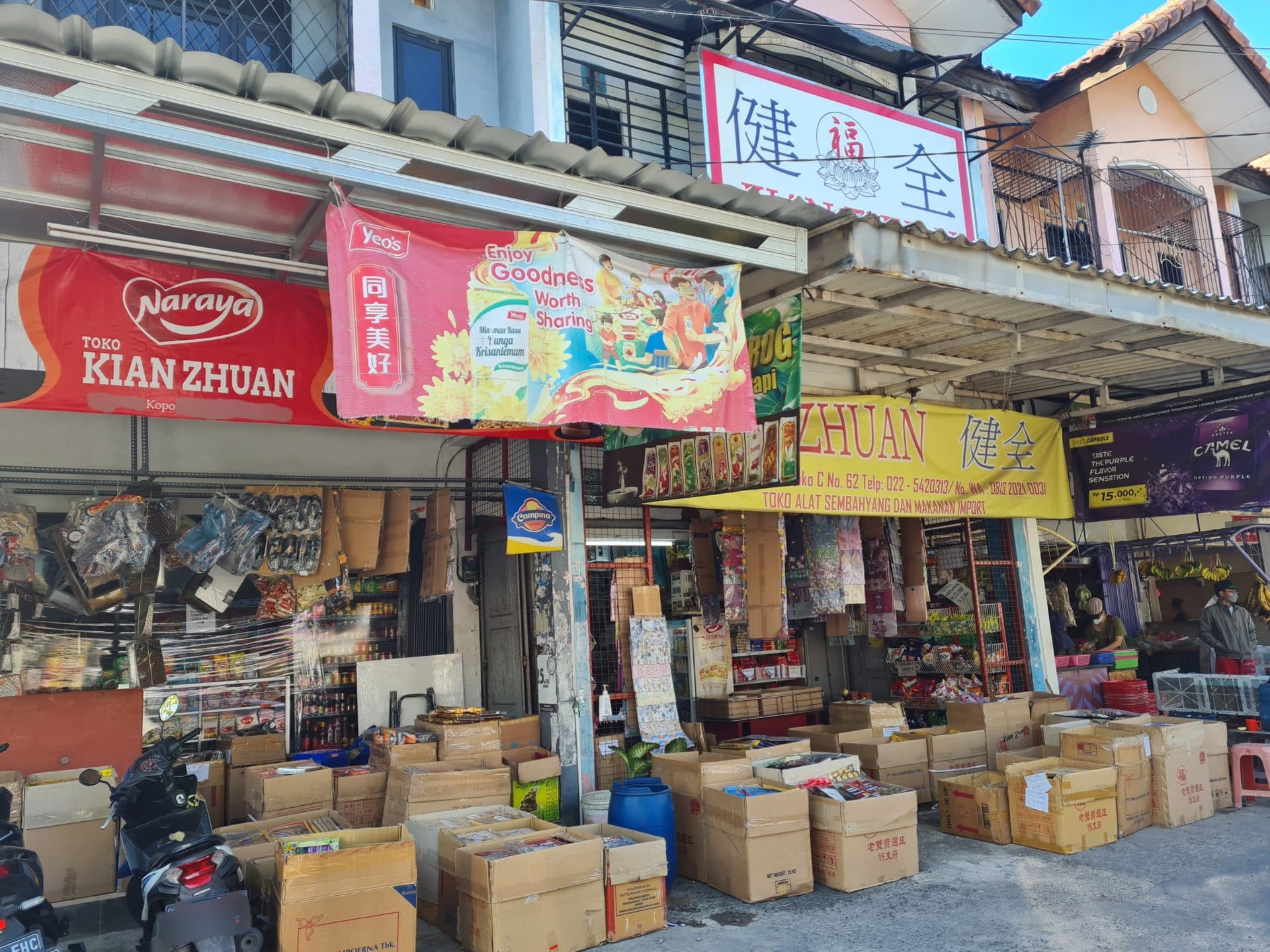
I reflect on things like this every time I walk. I take in the harmony amid the diversity. People here live side-by-side in peace.
*
For those of you who aren’t so familiar with Indonesian society, an RT is a local community organisation recognised and supervised by the government. One RT is made up of about 30 to 50 houses or families. At this point in history, the role of an RT is more about maintaining and preserving the community values that are embodied in the terms gotong royong, meaning mutual aid, and kekeluargaan, meaning a ‘family-style’ approach to managing relations.
Our RT head, Ibu Kaligis, is a small-statured mother. She’s no longer young, but she’s still in good shape, so much so that she moves with great speed. Every time I meet her, I note the makeup adorning her dark face. Her clothes and hijab she seems to always pick out very carefully so that they match. It’s obvious Ibu Kaligis wishes to look tidy and neat in the presence of residents who almost every day visit her home, or sometimes she visits their homes. One time, Ibu Kaligis said to me that RTs are now the most-ardent preservers of gotong royong and kekeluargaan. As I see it, if those things are at work here, it’s because Ibu Kaligis provides a role model to emulate.
Ibu Kaligis always greets every resident, she never differentiates. Even though the greeting is as simple as calling a name out, I for one feel happy that she remembers my name. Sometimes she also asks, ‘Mum and Dad are healthy? Is your brother still in Bali?’ Such attention makes me want to engage and interact back, to ask questions back to her. According to my mother, Ibu Kaligis always warmly welcomes the arrival of all new residents.
Ibu Kaligis is also full of concern when residents are hit by disaster, like an accident, an illness, or a family member who dies. She always asks for news, and families experiencing a crisis she entrusts to their neighbours. In the middle of the pandemic in 2021, my family had to isolate. That time was at once the most difficult and the most happy for me because, even though we were trapped in our house and had to ‘go to war’ against the virus, we always had enough to eat. Neighbours came and hung packets of food around our house, on our fence.
All this doesn’t mean the environment of our RT is perfectly harmonious. Recently I’ve witnessed clashes between neighbours. Actually, there have been two incidents. The first was because a pet dog was making noise and prompting a neighbour to get angry. The second was because a gate at the end of one residential street was being padlocked often, which affected people’s mobility.
When those clashes happened, I felt scared – especially during the brawl over the dog. Because one of the neighbours involved was right beside our house, and I could hear a man’s yell, full of rage: ‘Can that dog be quiet or not? The noise! If that dog cannot stay quiet, I will kill it!’ But as far as I know, in that case, the things propelling the clash did not widen. What I mean is, it didn’t become any sort of ethnic or religious problem – even though the people who were disagreeing indeed came from different ethnicities and religions. But that issue was resolved ‘as a family’.
During that clash, I felt scared – and I also noticed I had an impulse to defend one party over the other. Since then, I have worked to understand both of the parties, and to become more aware of just how large the challenge is to live in the middle of a community that is diverse. More and more diversity means more and more differences. Accepting and adapting to those differences is hard. As for me, I’ve needed many years to really come to do it.
It began when I experienced racism in Kopo. I was considered to not be a part of a particular ethnicity – even though, in my blood, that ethnicity does reside. It was extremely painful. Still-more so because I received such a rejection from representatives of the ethnicity in which I felt most comfortable – comfortable from familiarity. Slowly but surely, that rejection drowned me in a confusion of identity. I knew that I am not able to fully follow one culture and betray another. I am not made simply from one of the cultures that run in my family, I’m made from all of them.
When I experienced that racism, I was still young. I bemoaned what had happened to me frequently to my mother, and I cried. One individual racist encounter could make me cry over and over. Then, every time I recalled it, I drew on the wall of my room. Pouring out a hurt which I did not know how to resolve, apart from scrawling on that wall.
What made me forgive those painful events was this: I learnt, and I still continue to learn, how to treat fellow humans as humans. The choice of my parents to live in Kopo has opened a path for me to study diversity deeply. Living here, I’ve tried to study why people will do or believe something that’s different from me. It all pushes me to empathise and be patient when facing difference.
Sometimes I feel that, when differences are quite close, even very close, those differences don’t become so glaring. Similar to when we read some piece of writing with the distance between our eyes and the page very close, so close that the writing actually becomes hard to read. Maybe difference is like that. When up close, differences blur and become not felt. Or even lose their meaning.
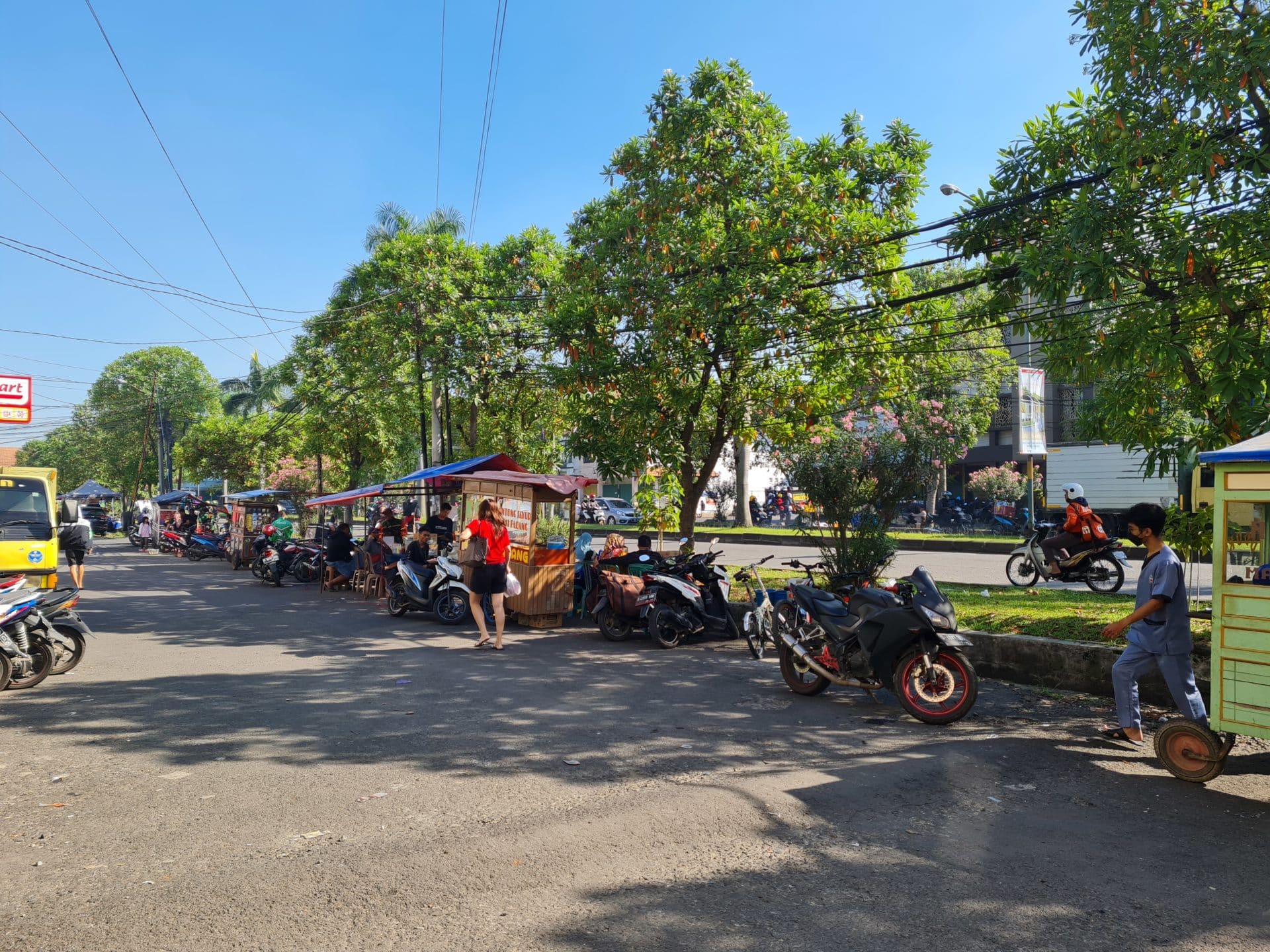
Kopo is not a perfect place. It’s just one small piece of Bandung. But I will continue to hold it in my heart. Because in Kopo, a place that has become a home for me, I have studied much about diversity, harmony, and their challenges.
Now, after I have learnt to forgive that racism of the past, the wall in my room I have had painted over.
© Joan Oktavianie
English translation © Lise Isles

-custom_crop.jpg)
